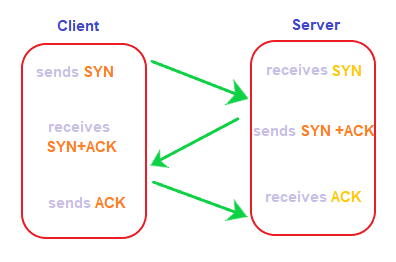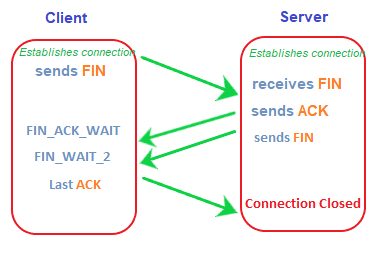TCP Connection Termination
TCP (Transmission Control Protocol) is a transmission protocol that ensures data transmission in an ordered and secure manner. It sends and receives the data packets in the same order. TCP is a four-layer protocol compared to OSI (Open System Interconnection Model), which is a seven-layer transmission process. It is recommended to transmit data from high-level protocols due to its integrity and security between the server and client.
TCP needs a 4-way handshake for its termination. To establish a connection, TCP needs a 3-way handshake. So, here we will discuss the detailed process of TCP to build a 3-way handshake for connection and a 4-way handshake for its termination. Here, we will discuss the following:
What is TCP?
Layers of TCP
TCP Connection (A 3-way handshake)
TCP Termination (A 4-way handshake)
Let’s start.
What is TCP?
TCP is a connection-oriented protocol, which means that it first establishes the connection between the sender and receiver in the form of a handshake. After both the connections are verified, it begins transmitting packets. It makes the transmission process error-free and ensures the delivery of data. It is an important part of the communication protocols used to interconnect network devices on the internet. The whole internet system relies on this network.
TCP is one of the most common protocols that ensure end-to-end delivery. It guarantees the security and integrity of the data being transmitted. It always establishes a secure connection between the sender and receiver. The transmitter is the server, and the receiver is known as the client. We can also say that the data transmission occurs between the server and client. Hence, TCP is used in most of the high-level protocols, such as FTP (File Transfer Protocol), HTTP (Hyper Text Transfer Protocol), and SMTP (Simple Mai Transfer Protocol).
Layers of TCP
The data is then divided into packets, assigned to the address, transmitted, routed, and received at the destination. The transmission process comprises four layers, application layer, transport layer, internet layer, and data link layer. The application layer performs the function similar to the top three layers (application, presentation, and session) of the OSI model and control user-interface specifications. The user interacts with the application layer of the TCP model, such as messaging and email systems. The transport layer provides a reliable and error-free data connection. It divides the data received from the application layer into packets, which helps in creating ordered sequence. The internet layer controls the routing of packet and ensures the delivery of a packet at the destination. The data link layer performs the function similar to the bottom two layers (data link and physical) of the OSI model. It is responsible for transmitting the data between the applications or devices in the network.
Before proceeding towards the TCP termination, it is essential to understand the concept of TCP connection. It will help us to better understand the termination process.
TCP Connection (A 3-way handshake)
Handshake refers to the process to establish connection between the client and server. Handshake is simply defined as the process to establish a communication link. To transmit a packet, TCP needs a three way handshake before it starts sending data. The reliable communication in TCP is termed as PAR (Positive Acknowledgement Re-transmission). When a sender sends the data to the receiver, it requires a positive acknowledgement from the receiver confirming the arrival of data. If the acknowledgement has not reached the sender, it needs to resend that data. The positive acknowledgement from the receiver establishes a successful connection.
Here, the server is the server and client is the receiver. The above diagram shows 3 steps for successful connection. A 3-way handshake is commonly known as SYN-SYN-ACK and requires both the client and server response to exchange the data. SYN means synchronize Sequence Number and ACK means acknowledgment. Each step is a type of handshake between the sender and the receiver.
The diagram of a successful TCP connection showing the three handshakes is shown below:

The three handshakes are discussed in the below steps:
Step 1: SYN
SYN is a segment sent by the client to the server. It acts as a connection request between the client and server. It informs the server that the client wants to establish a connection. Synchronizing sequence numbers also helps synchronize sequence numbers sent between any two devices, where the same SYN segment asks for the sequence number with the connection request.
Step 2: SYN-ACK
It is an SYN-ACK segment or an SYN + ACK segment sent by the server. The ACK segment informs the client that the server has received the connection request and it is ready to build the connection. The SYN segment informs the sequence number with which the server is ready to start with the segments.
Step 3: ACK
ACK (Acknowledgment) is the last step before establishing a successful TCP connection between the client and server. The ACK segment is sent by the client as the response of the received ACK and SN from the server. It results in the establishment of a reliable data connection.
After these three steps, the client and server are ready for the data communication process. TCP connection and termination are full-duplex, which means that the data can travel in both the directions simultaneously.
TCP Termination (A 4-way handshake)
Any device establishes a connection before proceeding with the termination. TCP requires 3-way handshake to establish a connection between the client and server before sending the data. Similarly, to terminate or stop the data transmission, it requires a 4-way handshake. The segments required for TCP termination are similar to the segments to build a TCP connection (ACK and SYN) except the FIN segment. The FIN segment specifies a termination request sent by one device to the other.
The client is the data transmitter and the server is a receiver in a data transmission process between the sender and receiver. Consider the below TCP termination diagram that shows the exchange of segments between the client and server.
The diagram of a successful TCP termination showing the four handshakes is shown below:

Let’s discuss the TCP termination process with the help of six steps that includes the sent requests and the waiting states. The steps are as follows:
Step 1: FIN
FIN refers to the termination request sent by the client to the server. The first FIN termination request is sent by the client to the server. It depicts the start of the termination process between the client and server.
Step 2: FIN_ACK_WAIT
The client waits for the ACK of the FIN termination request from the server. It is a waiting state for the client.
Step 3: ACK
The server sends the ACK (Acknowledgement) segment when it receives the FIN termination request. It depicts that the server is ready to close and terminate the connection.
Step 4: FIN _WAIT_2
The client waits for the FIN segment from the server. It is a type of approved signal sent by the server that shows that the server is ready to terminate the connection.
Step 5: FIN
The FIN segment is now sent by the server to the client. It is a confirmation signal that the server sends to the client. It depicts the successful approval for the termination.
Step 6: ACK
The client now sends the ACK (Acknowledgement) segment to the server that it has received the FIN signal, which is a signal from the server to terminate the connection. As soon as the server receives the ACK segment, it terminates the connection.
